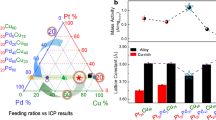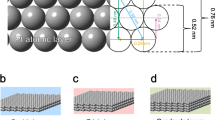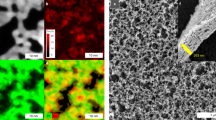Abstract
The improvement of catalysts for the four-electron oxygen-reduction reaction (ORR; O2+4H++4e−→2H2O) remains a critical challenge for fuel cells and other electrochemical-energy technologies. Recent attention in this area has centred on the development of metal alloys with nanostructured compositional gradients (for example, core–shell structure) that exhibit higher activity than supported Pt nanoparticles (Pt–C; refs 1,2,3,4,5,6,7). For instance, with a Pt outer surface and Ni-rich second atomic layer, Pt3Ni(111) is one of the most active surfaces for the ORR (ref. 8), owing to a shift in the d-band centre of the surface Pt atoms that results in a weakened interaction between Pt and intermediate oxide species, freeing more active sites for O2 adsorption2,9. However, enhancements due solely to alloy structure and composition may not be sufficient to reduce the mass activity enough to satisfy the requirements for fuel-cell commercialization10, especially as the high activity of particular crystal surface facets may not easily translate to polyfaceted particles. Here we show that a tailored geometric and chemical materials architecture can further improve ORR catalysis by demonstrating that a composite nanoporous Ni–Pt alloy impregnated with a hydrophobic, high-oxygen-solubility and protic ionic liquid has extremely high mass activity. The results are consistent with an engineered chemical bias within a catalytically active nanoporous framework that pushes the ORR towards completion.
This is a preview of subscription content, access via your institution
Access options
Subscribe to this journal
Receive 12 print issues and online access
$259.00 per year
only $21.58 per issue
Buy this article
- Purchase on Springer Link
- Instant access to full article PDF
Prices may be subject to local taxes which are calculated during checkout




Similar content being viewed by others
References
Greeley, J. et al. Alloys of platinum and early transition metals as oxygen reduction electrocatalysts. Nature Chem. 1, 552–556 (2009).
Paulus, U. et al. Oxygen reduction on high surface area Pt-based alloy catalysts in comparison to well defined smooth bulk alloy electrodes. Electrochim. Acta 47, 3787–3798 (2002).
Stamenkovic, V., Mun, B., Mayrhofer, K., Ross, P. & Markovic, N. Effect of surface composition on electronic structure, stability, and electrocatalytic properties of Pt-transition metal alloys: Pt-skin versus Pt-skeleton surfaces. J. Amer. Chem. Soc. 128, 8813–8819 (2006).
Stamenkovic, V. et al. Trends in electrocatalysis on extended and nanoscale Pt-bimetallic alloy surfaces. Nature Mater. 6, 241–247 (2007).
Zhang, J. et al. Platinum monolayer electrocatalysts for O2 reduction: Pt monolayer on Pd(111) and on carbon-supported Pd nanoparticles. J. Phys. Chem. B 108, 10955–10964 (2004).
Zhang, J. et al. Mixed-metal monolayer electrocatalysts for enhanced oxygen reduction kinetics. J. Am. Chem. Soc. 127, 12480–12481 (2005).
Nilekar, A. et al. Bimetallic and ternary alloys for improved oxygen reduction catalysis. Top. Catal. 46, 276–284 (2007).
Stamenkovic, V. et al. Improved oxygen reduction activity on Pt3Ni(111) via increased surface site availability. Science 315, 493–497 (2007).
Stamenkovic, V. et al. Changing the activity of electrocatalysts for oxygen reduction by tuning the surface electronic structure. Angew. Chem. Int. Ed. 45, 2897–2901 (2006).
Gasteiger, H., Kocha, S., Sompalli, B. & Wagner, F. Activity benchmarks and requirements for Pt, Pt-alloy, and non-Pt oxygen reduction catalysts for PEMFCs. Appl. Catal. B 56, 9–35 (2005).
Erlebacher, J., Aziz, M., Karma, A., Dimitrov, N. & Sieradzki, K. Evolution of nanoporosity in dealloying. Nature 410, 450–453 (2001).
Stamenkovic, V., Schmidt, T., Ross, P. & Markovic, N. Surface segregation effects in electrocatalysis: Kinetics of oxygen reduction reaction on polycrystalline Pt3Ni alloy surfaces. J. Electroanal. Chem. 554–555, 191–199 (2003).
Mani, P., Srivastava, R. & Strasser, P. Dealloyed Pt–Cu core–shell nanoparticle electrocatalysts for use in PEM fuel cell cathodes. J. Phys. Chem. C 112, 2770–2778 (2008).
Liu, Y., Bliznakov, S. & Dimitrov, N. Comprehensive study of the application of a Pb underpotential deposition-assisted method for surface area measurement of metallic nanoporous materials. J. Phys. Chem. C 113, 12362–12372 (2009).
Luo, H., Baker, G., Lee, J., Pagni, R. & Dai, S. Ultrastable superbase-derived protic ionic liquids. J. Phys. Chem. B 113, 4181–4183 (2009).
Gomes, M., Deschamps, J. & Menz, D. Solubility of dioxygen in seven fluorinated liquids. J. Fluorine Chem. 125, 1325–1329 (2004).
Paulus, U. et al. Oxygen reduction on carbon-supported Pt–Ni and Pt–Co alloy catalysts. J. Phys. Chem. B 106, 4181–4191 (2002).
Clouser, S. J., Huang, J. C. & Yeager, E. Temperature dependence of the Tafel slope for oxygen reduction on platinum in concentrated phosphoric acid. J. Appl. Electrochem. 23, 597–605 (1993).
Ghoneim, M. M., Clouser, S. & Yeager, E. Oxygen reduction kinetics in deuterated phosphoric acid. J. Electrochem. Soc. 132, 1160–1162 (1985).
Yeager, E., Razaq, M., Gervasio, D., Razaq, A. & Tryk, D. Proc. Workshop on Structural Effects in Electrocatalysis and Oxygen Electrochemistry vol. 92–11, 440 (The Electrochemical Society, 1993).
Damjanovic, A. & Brusic, V. Electrode kinetics of oxygen reduction on oxide-free platinum electrodes. Electrochim. Acta 12, 615–628 (1967).
Damjanovic, A. & Genshaw, M. A. Dependence of the kinetics of O2 dissolution at Pt on the conditions for adsorption of reaction intermediates. Electrochim. Acta 15, 1281–1283 (1970).
Markovic, N. M., Gasteiger, H. A., Grgur, B. N. & Ross, P. N. Oxygen reduction reaction on Pt(111): Effects of bromide. J. Electroanal. Chem. 467, 157–163 (1999).
Sepa, B., Vojnovic, M. & Damjanovic, A. Reaction intermediates as a controlling factor in the kinetics and mechanism of oxygen reduction at platinum electrodes. Electrochim. Acta 26, 781–793 (1981).
Zhang, J., Yang, H., Fang, J. & Zou, S. Synthesis and oxygen reduction activity of shape-controlled Pt3Ni nanopolyhedra. Nano Lett. 10, 638–644 (2010).
Markovic, N., Schmidt, T., Stamenkovic, V. & Ross, P. Oxygen reduction reaction on Pt and Pt bimetallic surfaces: A selective review. Fuel Cells 1, 105–116 (2001).
Srivastava, R., Mani, P., Hahn, N. & Strasser, P. Efficient oxygen reduction fuel cell electrocatalysis on voltammetrically dealloyed Pt–Cu–Co nanoparticles. Angew. Chem. Int. Ed. 46, 8988–8991 (2007).
Lim, B. et al. Pd–Pt bimetallic nanodendrites with high activity for oxygen reduction. Science 324, 1302–1305 (2009).
Mayrhofer, K. et al. Measurement of oxygen reduction activities via the rotating disc electrode method: From Pt model surfaces to carbon-supported high surface area catalysts. Electrochim. Acta 53, 3181–3188 (2008).
Shao-Horn, Y. et al. Instability of supported platinum nanoparticles in low-temperature fuel cells. Top. Catal. 46, 285–305 (2007).
Acknowledgements
We gratefully acknowledge support for this work by the US Department of Energy, Office of Basic Energy Sciences, under grant DE-FG02-05ER15727, and V. Stamenkovic (Argonne National Laboratory) for discussion and technical assistance in verifying the activity of np-NiPt for the ORR. We also acknowledge 3M, who generously supplied us with a sample of Li bis(perfluoroethylsulphonyl)imide.
Author information
Authors and Affiliations
Contributions
T.F. and M.W.C. carried out TEM characterization of the dealloyed np-NiPt material. Otherwise, J.S. and J.E. contributed equally in conceiving the new material, carrying out electrochemical characterization, data analysis and manuscript preparation.
Corresponding author
Ethics declarations
Competing interests
The authors declare no competing financial interests.
Supplementary information
Supplementary Information
Supplementary Information (PDF 1274 kb)
Rights and permissions
About this article
Cite this article
Snyder, J., Fujita, T., Chen, M. et al. Oxygen reduction in nanoporous metal–ionic liquid composite electrocatalysts. Nature Mater 9, 904–907 (2010). https://doi.org/10.1038/nmat2878
Received:
Accepted:
Published:
Issue Date:
DOI: https://doi.org/10.1038/nmat2878
This article is cited by
-
Mesoporous Pt@Pt-skin Pt3Ni core-shell framework nanowire electrocatalyst for efficient oxygen reduction
Nature Communications (2023)
-
Tafel Slope Analysis from Inherent Rate Constants for Oxygen Reduction Reaction Over N-doped Carbon and Fe–N-doped Carbon Electrocatalysts
Catalysis Surveys from Asia (2023)
-
Application of Solid Catalysts with an Ionic Liquid Layer (SCILL) in PEMFCs: From Half-Cell to Full-Cell
Electrochemical Energy Reviews (2023)
-
Topological control of liquid-metal-dealloyed structures
Nature Communications (2022)
-
Solid–liquid–gas reaction accelerated by gas molecule tunnelling-like effect
Nature Materials (2022)



